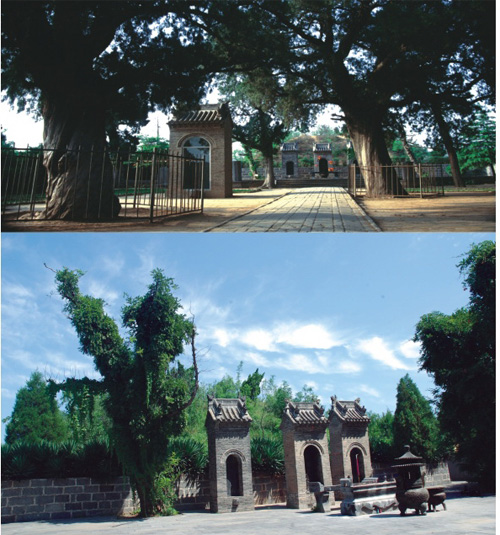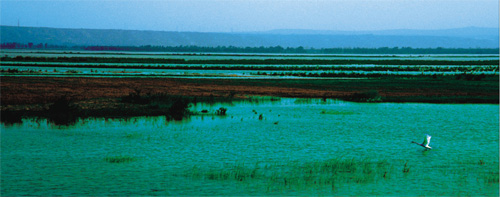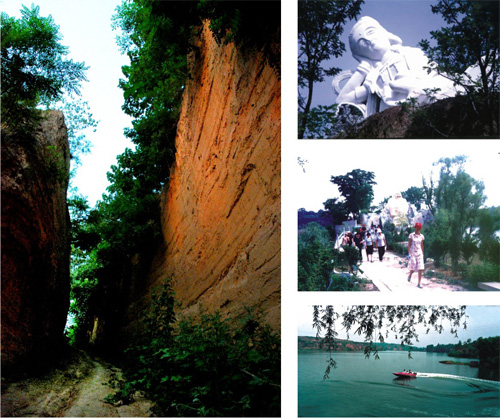

1. Hanyu Cemetery
Hanyu Cemetery is a state protected historic site as well as a national AAA tourist attraction, 6 km away from the urban area in the west of Mengzhou, at the north side of Luoyang-Changping Expressway, at the foot of the sunny slope of Purple Mountain, with a total area of more than 100 mu. Hanyu (768-824) (given name: “Tuizhi”), born in Heyang (former name of Mengzhou), was an outstanding litterateur, politician, ideologist and poet in the Tang Dynasty. In literature, Hanyu was the leader of the Ancient Prose Campaign, advocating the prose and fighting against the parallel prose, who was ranked first among the top 8 prosers of the Tang and Song Dynasties. In philosophy, Hanyu safeguarded Confucianism against Buddhism and Taoism. In politics, Hanyu upheld centralism against splittism. Moreover, Hanyu was well-performed in education.
Hanyu Cemetery was built in the first year of the reign of Tang Jingzong, with a history of 1180 years. Its main buildings in the tourist attraction include Pailou, Shendao, white marble statues of the top 8 prosers of the Tang and Song Dynasties and Han Xiangzi, altar, stone steps, gate, pavilion, dining courtyard, tomb, tombstones, etc., magnificent and spectacular. The ancient cypresses inside Hanyu Cemetery are luxuriantly green. In particular, two cypresses, which were transplanted from Chang’an according to Hanyu’s last wish 1180 years ago, grow with luxuriant leaves foliage and spreading branches and slant towards the southwest, symbolizing that Hanyu will remember the law of an imperial court, miss his colleagues and worry about the rise and fall of the nation. Hanyu’s great achievements and contribution, admired by the later generations, have a great impact on the development of Chinese literature. Moreover, Hanyu was widely influential in the USA, Japan, South Korea and Southeast Asia. Especially after 1980s, some Hanyu-related research institutes in the world have been built, e.g., China International Hanyu Research Society, built in Hanyu Cemetery. In recent years, Hanyu Cemetery has received numerous domestic and overseas visitors, and many Party and state leaders, such as Jiang Zemin, Hu Jintao, Qiao Shi, Li Changchun, Zeng Qinghong, Li Tieying, Wu Jieping, Sun Fuling, Li Desheng, Jiang Zhenghua, Han Qide, etc. Jiang Zemin inscribed the name of Hanyu Cemetery. In Mar. 2005, Worldwide Han’s Ancestor Worship (Family Root Seeking) Conference was held in Hanyu Cemetery, and have attracted more than 300 Han’s descendants from mainland China, Hong Kong, Taiwan, Singapore, Malaysia, Brunei, etc., which carried forward Hanyu culture and expanded the popularity of Hanyu Cemetery. Its exclusive cultural connotation makes Hanyu Cemetery into a tourist attraction of central plain culture.


2. Yellow River Wetland
The Yellow River, China’s second largest river, runs through Mengzhou up to 30 km and forms a wide fluvial plain - Yellow River Riffle Zone. The Yellow River Wetland has a wide area, high forest coverage rate, rich wildlife resources and attractive natural ecological environment. It has been approved as a provincial-level forest park in 2001 and a Yellow River Wetland National Nature Reserve in 2003.
Mengzhou Yellow River Wetland National Nature Reserve is a habitat of many wild animals and plants, with abundant wild resources and diversified species. The wetland is crossed by rivers, marshes and ponds, with a total area of 2719 ha., and water area 3200 ha.. In the wetland, you can see various animals (such as otter, grass hare, field mouse, etc.), more than 30 kinds of birds (such as magpie, garganey, tufted duck, spot-billed duck, great egret, pheasant, geese, crane, etc.), beach reptiles (elaphe taeniura, dinodon rufozonatum, frog, toad, etc.), etc.
Its main scenic spots include: Daba Park, Yellow River Tower, Yellow River Harnessing Sculpture Garden, folk customs village, sightseeing picking orchard, wetland rose willow forest, sandpit, wild goose beach, swimming beach, racecourse, fishermen’s family by the Yellow River, barbecue night market, etc.
Mengzhou Yellow River Wetland National Nature Reserve has a total area of 100,000 mu, and the resort has an area of 11 sq. km. It is 3.5 km from the urban area of Mengzhou, 40 km from Luoyang and 20 km from Xiaolangdi.


3. Gucheng Lake
Gucheng Lake Tourist Attraction consists of Ancient Zhou City-Wall and Shunjian Lake, adjacent to Taihang Mountain in the north and the Yellow River in the south. Ancient Zhou City-Wall is located in Guzhoucheng Village, Huaishu Town on the hilly land in the northwest of Mengzhou. Inside the resort is an ancient Zhou city-wall site (ancient Heyang city), connected with the Shunjian Lake (known as “Little West Lake”), surrounded by the mountain and lake, with beautiful landscape. It has a land area of 1.5 sq. km. and a water area of nearly 5 sq. km. Ancient Zhou City-Wall, also called as “King Xiang of Zhou Pilgrimage City”, is located at the south bank of Shunjian Lake, where the visitors can see some historical sites (such as ancient city wall, ancient plank road, Qian-Sui-Fen, Lie-Fu-Jing, Bai-Yi-Tang, etc.), human landscapes (such as cultural plaza, cultural cave dwelling, Wang-Du-Ge, Lin-Shui-Xie, Maitreya, viewing deck, amusement park, north city gate, etc.), mountain and lake, orchard and garden. Here, the visitors can view the ancient city, associate with the long history of Huaxia (an ancient name for China), enjoy fresh and elegant nature landscape, and taste the pastoral pleasure. Its unique beautiful natural landscape and profound historical and cultural connotation attracted the screws of TV play series Diao Chan and Legend of Heroic Duo. Moreover, it has been rated as Henan Culture Relic Protection Site and CCTV’s location shooting base of Jiaozuo Film and Television City.
Shunjian Lake, also called as Tianwang Lake, is located in the Wenshui River, 15 km away from the urban area in the west of Mengzhou, with a water area of 30 sq. km. It was said that, in BC 630, King Xiang of Zhou, who felt depressed upon his pilgrimage in Heyang City and ascended a height to enjoy a distant view by the lake frequently, shed his tears into the lake, so the lake got its name. Standing on the Ancient Zhou City-Wall, you can view range upon range of mountains, and steep mountains, green trees on the mountains, and drooping willows by the river. The lake is connected with many bends, each bend having different landscapes, waves glistening, boats moving on the lake, birds flying over the lake. The water and the sky merge in one color. With big islands, small slopes, long mountain ranges and short mountain ridges, such beautiful sceneries can be seen everywhere. More than 20 scenic spots, such as Wanzi Mountain, Shexian Bay, Niushe Bay, Wulou Ditch, etc., have their own exclusive beautiful legends. Viewing the Ancient Zhou City-Wall opposite the lake, the whole city seems to be built in the lake, with black bricks, grey wall and green trees reflecting into the water like a wash painting, glistening waves and inverted image setting each other off beautifully. The tourists on the lake, poling or paddling, move around the lake, which make you relaxed and happy.


4. Suomang Lake
Suomang Lake, also called as Baiqiang Lake, is Mengzhou’s largest reservoir. On the lakeshore are green grass, flying reed catkins and drooping willows reflecting in the glistening waves. In March, when catkins fly over the Suomang Lake in the spring breeze, rowing on the lake, you seem to come into a fairyland.
Reed beach is a major scenic spot inside Suomang Lake Tourist Attraction, greening in spring, cool in summer and blossoming in autumn. As the habitat of wild ducks, swans and fiegles, the reed beach is a good place for exploration, novelty-hunting and relaxation. Here, you can see clear running water, blossoming flowers and cool breeze in four seasons. The reed beach is a summer resort in June and July.
White swan habitat is another major landscape inside Suomang Lake Tourist Attraction, with a water area of 11.10 sq. km and a beach area of 5.6 sq. km, with zigzag lakeshore and high forest on the lakeside, island and peninsula connecting with each other. In October and at the end of March, hundreds of white swans live through the winter inside Suomang Lake, which greatly attract many tourists.

 中文
中文 English
English русский
русский Español
Español


